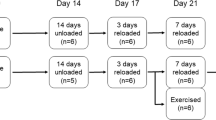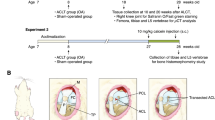Abstract
Bone change induced by knee immobilization was assessed on dissected femurs and tibias to clarify the influences upon the mechanical properties and their demands. Fifty-eight Wistar-Imamichi male rats (11–12 weeks old, body weight 350–450 g) were subjected to knee joint immobilization (150° flexed position) on one side while the opposite side served as a control. Animals were killed in seven groups at time intervals of 1, 2, 3, 4, 5, 7, and 10 weeks. The hind leg was extirpated and prepared for (1) biomechanical analysis by the indentation method at the articular surfaces of the femoral condyle and head and at the subchondral bone of the proximal tibia, and for (2) dual-energy X-ray absorptiometry of the distal metaphysis of the femur. The biomechanical parameters measured induced dynamic stiffness and phase lag derived from forced oscillation (preload 3 N, cyclic load 2 N and 11 Hz, 35 Hz), and bone mineral density was analyzed. These were compared between the immobilized side and control side, and among the seven time groups. The biomechanical results showed an early change of osteocartilaginous properties at the femoral condyle, a late response at the tibial subchondral bone, and no change at the femoral head. The measurement of bone mineral density revealed that a very sensitive reaction started within 1–2 weeks. This study provides objective data demonstrating that disuse or lack of mechanical stress greatly affects the remodeling activity for homeostasis of joints, and dramatically impairs normal bone mineral density next to the immobilized joint in young animals.
Similar content being viewed by others
References
Akeson WH, Woo SL-Y et al (1974) Biomechanical and biochemical changes in the periarticular connective tissue during contracture development in the immobilized rabbit knee. Connect Tissue Res 2:315–323
Akeson WH, Woo SL-Y et al (1977) Rapid recovery from contracture in rabbit hindlimb; a correlative biomechanical and biochemical study. Clin Orthop 122:359–365
Akeson WH, Amiel D et al (1987) Effects of immobilization on joints. Clin Orthop 219:28–37
Evans EB, Eggers GWN et al (1960) Experimental immobilization and remobilization of rat knee joints. J Bone Joint Surg [Am] 42:737–758
Greenleaf JE (1984) Physiological responses to prolonged bed rest and fluid immersion in humans. J Appl Physiol 57:619–633
Hall MC (1963) Cartilage changes after experimental immobilization of the knee joint of the young rat. J Bone Joint Surg [Am] 45:36–44
Indrekvam K, Husby OS et al (1991) Age-dependent mechanical properties of rat femur; measured in vivo and in vitro. Acta Orthop Scand 62:248–252
Jergas M, Grampp S et al (1993) Perspectives on bone densitometry; past/present/future. J Bone Miner Met 11(Suppl 2):s7-s16
Jones LC, Niv AI et al (1982) Bone blood flow in the femora of anesthetized and conscious dogs in a chronic preparation; using the radioactive tracer microsphere method. Clin Orthop 170:286–295
LeBlanc A, Marsh C et al (1985) Bone and muscle atrophy with suspension of the rat. J Appl Physiol 58:1669–1675
Li XJ, Jee WSS et al (1990) Adaptation of cancellous bone to aging and immobilization in the rat; a single photon absorptiometry and histomorphometry study. Anat Rec 227:12–24
Mbuyi-Muamba JM, Dequeker J (1986) Bone mass measured by photon absorptiometry and radiogrammetry in Wistar rats; age and sex variations. Invest Radiol 21:336–339
Okubo M, Kinoshita T et al (1979) Experimental study of measurement of regional bone blood flow in the adult mongrel dog using radioactive microspheres. Clin Orthop 138:263–270
Suzuki H, Nakai M et al (1994) Measurement of regional blood flow in atrophied rat femur using radiolabeled microsphere method. (in Japanese) Autonom Nerv Sys 31:705–709
Thaxter TH, Mann RA et al (1965) Degeneration of immobilized knee joints in rats; histological and autoradiographic study. J Bone Joint Surg [Am] 47:567–585
Whedon GD (1984) Disuse osteoporosis; physiological aspects. Calcif Tissue Int 36 (Suppl 1):s146-s150
Wilson CJ, Dahners LE (1988) An examination of the mechanism of ligament contracture. Clin Orthop 227:286–291
Woo SL-Y, Matthews JV et al (1975) Connective tissue response to immobility; correlative study of biomechanical and biochemical measurements of normal and immobilized rabbit knees. Arth Rheum 18:257–264
Yaoita M (1966) Effect of immobilization and subsequent remobilization of the knee joints of the rats. (in Japanese) J Jpn Orthop Assoc 40:431–453
Author information
Authors and Affiliations
Rights and permissions
About this article
Cite this article
Akai, M., Shirasaki, Y., Tateishi, T. et al. Localized osteoarticular change due to joint immobilization; biomechanical test and bone densitometry in rat's hind limb model. Arch Orthop Trauma Surg 116, 129–132 (1997). https://doi.org/10.1007/BF00426060
Received:
Issue Date:
DOI: https://doi.org/10.1007/BF00426060




